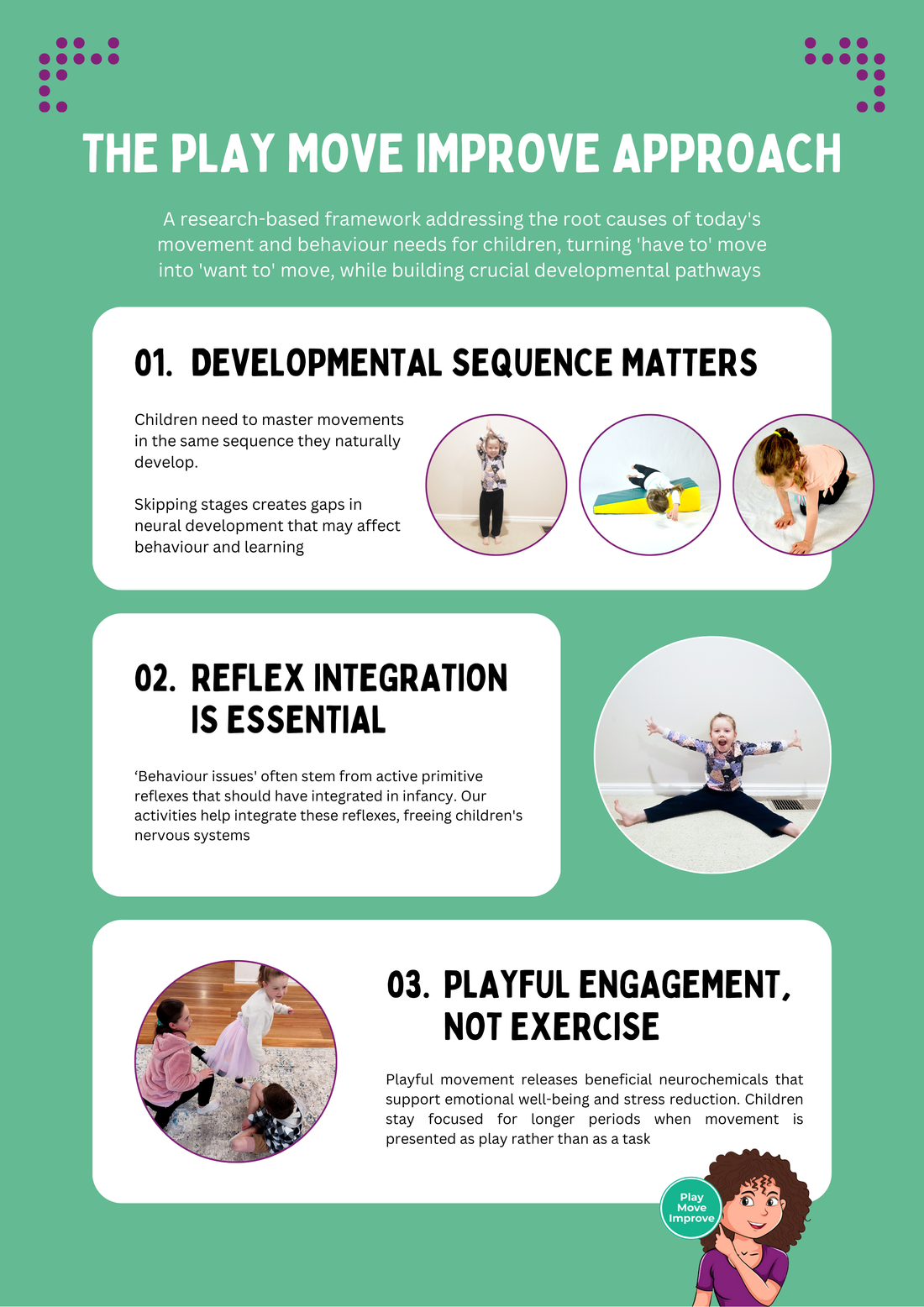
The Play Move Improve Approach: A Framework for Movement, Behaviour and Learning
Share
As I sit here reflecting on my years working with children across Australia, I'm struck by how dramatically the childhood landscape has shifted. I remember walking into my first kindergarten classroom 15 years ago versus what I see today – the contrast is stark.
Our little ones are arriving at kindy with movement abilities I would've never questioned before. The things we took for granted – that children naturally learn to roll, crawl, balance – are no longer developing as they once did.
This realisation didn't come overnight. It emerged through thousands of observations, hands-on work with struggling children, and countless conversations with frustrated educators who kept asking me the same question: "Why can't they just sit still and listen?"
My response always begins the same way – it's not about behaviour; it's about movement.
This led me to develop what I now call the Play Move Improve approach. It wasn't born in a research lab (though the science certainly backs it up). It evolved from real work with real kids who needed help. Let me walk you through the three core principles I've found make all the difference.
1. Developmental Sequence Matters
I'll never forget working with Mia (not her real name), a 5-year-old who could recite the alphabet but couldn't hold a pencil properly. Her mum was baffled – how could such a "smart" child struggle with something so basic?
The answer lay in her movement history. Like many modern kids, Mia had limited tummy time as a baby (she screamed when placed on her tummy, so her well-meaning parents avoided it). She never properly crawled, instead scooting on her bottom until walking.
These weren't just missed physical milestones – they were missed neural development opportunities. Our nervous systems build in a specific sequence, each movement pattern laying groundwork for the next. When we skip steps, gaps form.
For Mia, missing those crawling patterns meant:
- Her shoulders lacked the stability needed for fine motor control
- Her eyes hadn't developed tracking patterns needed for reading
- Her body awareness in space was compromised
We had to go back and rebuild those foundations through targeted movement activities that respected the developmental sequence her body had missed.
This is why our movement cards don't just jump straight to "kindergarten skills." They methodically build from the ground up, ensuring each child has a complete movement foundation.
2. Reflex Integration is Essential
"He's just defiant," the frustrated educator told me about 4-year-old Jackson, who seemed to ignore every instruction and bumped into children constantly.
But watching Jackson, I noticed something telling – when his head turned right, his right arm subtly extended. Classic signs of a retained Asymmetrical Tonic Neck Reflex (ATNR).
These primitive reflexes are meant to integrate (disappear from conscious movement) during infancy. When they don't, they create involuntary responses that look remarkably like behavioural choices but aren't.
I see this daily:
- The child who "refuses" to sit still – often has an active Spinal Galant reflex triggered by the back of their chair
- The child who seems to "ignore" instructions – frequently has vestibular processing issues from retained primitive reflexes
- The child who "overreacts" to every small bump – typically shows signs of an active Moro (startle) reflex
After six weeks of targeted reflex integration activities disguised as games, Jackson's classroom behaviour transformed. He wasn't making "better choices" – his nervous system was finally free to respond appropriately.
Our programs build in these reflex integration activities naturally, as playful games rather than clinical exercises.
3. Playful Engagement, Not Exercise
Last month I visited a centre where children were being made to do "movement exercises" in rigid, drill-like fashion. The educator was well-meaning but missing the point entirely.
Children learn through play. It's not just more fun – it's neurologically different.
I still laugh remembering a group of "challenging" kinder kids who supposedly couldn't focus for more than two minutes. Yet when we introduced our "Jungle Explorer" game (secretly targeting vestibular and proprioceptive systems), they played with complete engagement for 20 minutes straight.
The playful approach changes everything:
My heart swells watching children's faces light up as neural connections form through joyful movement. When they beg to play the "Crocodile Crawl" again (not knowing it's integrating their STNR reflex), I know we've found the sweet spot where development and delight meet.
Putting It Into Practice
After a workshop last year, an educator sighed, "This all sounds great, but we're already stretched so thin."
I get it. That's why our 8-Week Self-Regulation & Motor Skills Program is designed for busy real-world settings. Everything is included:
- Simple assessment tools that don't require special training
- Clear activity cards sequenced for developmental progression
- Playful reflex integration games that children adore
- Practical tracking tools to document the improvements you'll see
- Implementation strategies that fit into your existing routine
The beauty lies in its simplicity. Most activities need minimal prep and fit into 5-15 minute windows throughout the day. One kindergarten incorporated the "Animal Walks" into their transition times and found they actually saved time by reducing behaviour management needs.
My Personal Promise
I developed this approach because I've lived the frustration from both sides – as a professional seeking answers and as a parent watching my own child struggle. The Play Move Improve approach transformed my practice, my classroom, and most importantly, my son's life.
Movement isn't just something children do. It's how they build themselves from the inside out.
If you're seeing challenging behaviours, declining attention spans, or movement difficulties, I'd love to help you implement these principles in your setting. Sometimes the smallest movement changes create the biggest developmental leaps.
Drop me an email or explore our resources. Movement challenges can become movement opportunities – I see this transformation every single day.